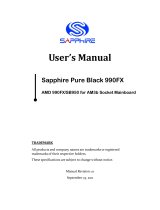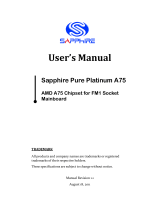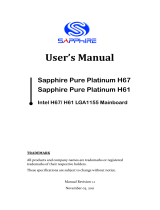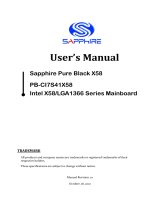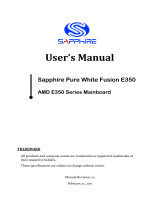Page is loading ...

User’sManual
Sapphire Pure Platinum Z77/Z77K
Intel Z77 / LGA1155 Mainboard
TRADEMARK
Allproductsandcompanynamesaretrademarksor registered
trademarksoftheirrespectiveholders.
Thesespecif icationsaresubjecttochangewithoutnotice.
ManualRevision1.0
March23,2012

~ii~
FederalCommunicationsCommission(FCC)Statement
This device has been tested and found to comply with the limits for a Class B
digital device, pursuant to Part 15 of FCC Rules. These limits are designed to
provide reasonable protection against harmful interference in a residential
installation. This equipment generates, uses and can radiate radio frequency
energy and, if not installed and used in accordance with instructions contained
in this manual, may cause harmful interference to radio and television
communications. However, there is no guarantee that interference will not occur
in a particular installation.
If this product does cause harmful interference to radio or television reception,
which can be determined by turning the equipment off and on, the user is
encouraged to try to correct the interference by one or more of the following
measures:
Reorient or relocate the receiving antenna.
Increase the separation between the equipment and receiver.
Connect the product into an outlet on a circuit different from that to which
the receiver is connected.
Consult the dealer or an experienced radio/TV technician for help.
Note1:
Connecting this device to peripheral devices that do not comply with Class
B requirements, or using an unshielded peripheral data cable, could also
result in harmful interference to radio or television reception
Note2: The user is cautioned that any changes or modifications not expressly
approved by the party responsible for compliance could void the user’s
authority to operate this product.
Note3: To ensure that the use of this product does not contribute to
interference, it is necessary to use shielded I/O cables
CE:RadiationofEN55022&ImmunityofEN55024
WasteElectricalandElectronicEquipment(WEEE)Statement
Toprotecttheglobalenvironment,thisproductmustbesenttoseparatecollection
facilitiesforrecoveryandrecycling.
DISPOSAL
Donotdisposeofthisproductasunsortedmunicipalwaste.Collectsuch
wasteseparatelyforspecialtreatment.

~iii~
Table of Contents
Chapter 1 Introduction .............................................................. 1
1-1 Mainboard Specifications ........................................................... 1
1-2 Package Contents ..................................................................... 4
1-3 Mainboard Layout ...................................................................... 5
Chapter 2 Installation .............................................................. 10
2-1 Before You Begin ..................................................................... 10
2-2 Installing the I/O Shield ............................................................ 10
2-3 Securing to the Chassis ........................................................... 10
2-4 Installing the CPU and Cooler .................................................. 11
2-5 Installing System Memory ........................................................ 11
Memory configurations ............................................................. 12
Memory Installation .................................................................. 12
2-6 Installing Expansion Cards ...................................................... 13
2-7 Connecting Cables .................................................................. 15
Connecting Power Supply Cables ............................................ 15
Connecting Serial ATA (SATA) Cables ...................................... 16
Connecting to the Internal Headers and Connectors ............... 16
Front Panel Header ............................................................ 17
USB2.0 Headers ................................................................. 18
USB3.0 Headers ................................................................. 18
CFPA Header ...................................................................... 19
S/PDIF Header ................................................................... 19
Serial Port Header .............................................................. 19
2-8 Diagnostics LED ...................................................................... 21
2-9 LED Status Indicators .............................................................. 21
2-10 Onboard Buttons .................................................................... 22
Clear CMOS Button ................................................................. 22
Reset and Power Button .......................................................... 22
2-11 Dual BIOS Switch ................................................................... 23
Chapter 3 Configuring the BIOS ............................................ 25
3-1 Select Boot Device .................................................................. 25
3-2 Enter BIOS Setup .................................................................... 25

~iv~
3-3 Main Menu ............................................................................... 27
3-4 Performance Menu .................................................................. 28
CPU Configuration ................................................................... 29
Memory Configuration .............................................................. 31
Voltage Configuration ............................................................... 33
3-5 Advanced Menu ....................................................................... 34
ACPI Settings ........................................................................... 35
S5 RTC Wake Settings ............................................................. 36
CPU Configuration ................................................................... 37
CPU Information ....................................................................... 38
SATA Configuration .................................................................. 39
USB Configuration ................................................................... 40
Super IO Configuration ............................................................. 41
Serial Port 0 Configuration ....................................................... 41
H/W Monitor ............................................................................. 42
Smart Fan Configuration .......................................................... 43
Onboard Device Configuration ................................................. 44
3-6 Chipset Menu ........................................................................... 45
3-7 Boot Menu ............................................................................... 47
3-8 Security Menu .......................................................................... 48
3-9 Save & Exit Menu .................................................................... 49
Chapter 4 Driver Installation ................................................ 51
4-1 Driver Install ............................................................................. 51
4-2 TRIXX Utility ............................................................................ 52
4-3 Hardware monitor gadget ........................................................ 53
4-4 S_BIOS Flash Utility ................................................................ 54
Chapter 5 POST Code .......................................................... 59

~1~
Chapter 1 Introduction
1‐1MainboardSpecifications
CPU
Supports Intel
®
Core i7/i5/i3 series processor in LGA1155 package
Supports Intel
®
Turbo Boost technology, Hyper-Threading technology
Chipset
Intel
®
Z77 chipset
Graphics
Intel
®
HD graphic
Four independent displays supporting concurrent display of either two
combination of HDMI, DVI, VGA and Display Port
Port Supported resolution
VGA 2048x1536@75MHz
DVI-D 1920x1200@60MHz
HDMI 1920x1200@60MHz
Display Port 2560x1600@60MHz
System Memory
Four 240-pin DDR3 SDRAM DIMM sockets
Supports 1.5v DDR3-1066/ 1333/ 1600+ DIMMs with dual channel architecture
Supports x16 and x8 DIMMs, non-ECC, unbuffered DIMMs
Supports up to 32GB system memory
USB Ports
Ten USB 2.0 ports (four at rear panel, six onboard headers), supporting transfer
speed up to 480Mbps
Four USB 3.0 ports (two at rear and two onboard headers) backward
compatible with USB 2.0, supporting transfer speeds up to 4.8Gbps
Supports wake-up from S1, S3 and S4 modes
Support power charge function
- Front panel 2 USB 3.0 ports also support power charge function under S5
mode

~2~
SATA Ports
Two SATA3 ports with 6Gb/s data transfer rate and four SATA2 ports with
3Gb/s data transfer rate
Support Intel
®
Rapid Start Technology with RAID 0, 1, 10 and 5
Supports Intel
®
Smart Response Technology
Supports AHCI (Advanced Host Controller Interface)
Onboard LAN
One Gigabit Ethernet from Realtek
®
RTL8111F Gigabit controller
One Gigabit Ethernet from Killer E2200 Gigabit controller (Optional)
Onboard Audio
Supports 8-channel High-Definition audio from Realtek ALC892 codec
Supports rear panel Optical S/PDIF output
Supports Jack-detection function
Expansion Slots
Three PCI-Express 3.0 x16 slots
One PCI-Express 2.0 x16 slots
Two PCI-Express 2.0 x1 slots
Supports AMD
®
CrossFireX
TM
Technology
* Please refer to detail configuration at 2-6 Installing Expansion Cards
I/O
Onboard Fintek F71889A LPC bus I/O controller
Supports Hardware Monitoring for fan speed, CPU and system temperature
Back Panel I/O Ports
1 x PS/2 Keyboard/Mouse port
4 x USB 2.0 ports
1 x Optical S/PDIF Out connector
1 x HDMI port
1 x Display port
1 x VGA port
1 x DVI-D port
2 x RJ45 LAN ports (one for optional)

~3~
2 x USB 3.0 ports
6 Audio jacks
Internal I/O Connectors
1 x 24-pin ATX power connector
1 x 8-pin ATX 12V power connector
1 x 4-pin power connector
2 x SATA3 connectors
4 x SATA2 connectors
6 x USB2.0 headers
2 x USB3.0 headers
1 x Front Panel header
1 x S/PDIF header
1 x Front Audio header
1 x Serial Port header
1 x 4-pin CPU Fan header
5 x 3-pin Fan headers
BIOS
64Mb SPI Flash with AMI based BIOS
User Friendly graphics interface QBIOS (Quick Control UEFI BIOS)
S_BIOS easily update and back up at BIOS control panel
Supports ACPI (Advanced Configuration and Power Interface)
Dual BIOS with select switch
Special Features
Onboard diagnostic 7-Segment LED with CPU temperature display
Onboard buttons include Clear CMOS, RESET and POWER
Supports CPU Power Vcore Load-line adjust function
Supports Windows based OC utility “Trixx” and Win7 HW monitor gadget tool
USB power charge utility supports all USB ports under Windows 7
8+2+2 phase power design (VCore, Vtt and VDIMM)

~4~
Form Factor
ATX form factor of 305mm x 245mm
Operating systems:
Supports Windows Vista and Windows 7
1‐2PackageContents
Your Sapphire mainboard comes with the following accessories.
1. Mainboard 2. I/O Shield
3. Quick Installation Guide 4. Driver DVD
5. USB3.0 Front Panel Cable (Optional) 6. SATA Data Cable *6

~5~
1‐3MainboardLayout
The following figure shows the location of components on the mainboard. See
following page for description.
Note:
Pictureisforreferenceonly,actualboardmaybeslightlydifferent.

~6~
Item Componentdescription
1 CPUSocket1155
2 IntelZ77Chip
3 DDR3DIMMSlots1‐4
4 PCI‐E3.0x16Slots*3
5 PCI‐E2.0x16Slots*1
6 PCI‐E2.0x1Slot*2
7 24‐PinATXPowerConnector
8 8‐pinATX_12V PowerConnector
9 4‐pinPowerConnector
10 SATA3Connectors*2
11 SATA2Connectors*4
12 FrontPanelHeader
13 USB2.0Header*6
14 USB3.0Header*2
15 PowerButton
16 ResetButton
17 ClearCMOSButton
18 SerialportHeader
19 FrontPanelAudioHeader
20 S/PDIFHeader
21 CPUFanHeader
22 3‐pinFanHeader*5
23 MainboardBattery
24 DebugLEDDisplay
25 PCSpeaker
26 64MbSPIFlash
27 DualBIOSSwitch
28 BackPanelConnectors(seebelowfordetail)

~7~
I/OBackPanel
The I/O back panel for this mainboard is shown below. When installing the
mainboard into the computer case, use the bundled I/O shield to protect this
back panel.
1. PS/2 Keyboard/Mouse Port
This connector is used for a keyboard or mouse. You can plug a PS/2
keyboard or mouse directly into this connector.
2. USB 2.0 Ports (four)
The mainboard provides an OHCI (Open Host Controller Interface) Universal
Serial Bus root for attaching USB devices such as a keyboard, mouse or
other USB-compatible devices. Supports data transfer rates up to 480Mb/s.
3. Optical S/PDIF-Out
This SPDIF (Sony & Philips Digital Interconnect Format) connector is used
for digital audio transmission to external speakers/amplifier through an
optical fiber cable.
4. The HDMI (High-Definition Multimedia Interface) provides an all-digital
audio/video interface to transmit the uncompressed audio/video signals
and is HDCP compliant. Connect the HDMI audio/video device to this port.
5. Display Port
The DisplayPort is a digital display interface standard. This connector is used
to connect a monitor with DisplayPort inputs.
6. VGA Port
The VGA female port provides connection to analogue VGA monitors.
7. DVI-D Port
The DVI-D (Digital Visual Interface-Digital) port provides a high-speed

~8~
digital interconnection between the computer and its display device.
Connect a monitor that supports DVI-D connection to this port. The DVI-D
port does not support analogue VGA monitors using a passive DVI to VGA
adapter.
Dual Display Configurations:
This mainboard provides four ports for video output: VGA, DVI-D, HDMI
and Display port. It displays combination of either two. Please refer to table
below for dual display configurations supported.
Supported configurations
VGA + DVI-D
VGA + Display Port
VGA + HDMI
DVI-D + Display Port
DVI-D + HDMI
Display Port + HDMI
8. LAN Ports with LEDs by Killer E2200 (Optional)
9. LAN Ports with LEDs by Realtek
®
RTL8111F
The mainboard provides standard RJ-45 jacks for connecting to a Local Area
Network (LAN). Two LEDs are built into the RJ-45 LAN connector. These
LEDs indicate the status of the LAN.
10. USB 3.0 ports (two)
USB 3.0 ports are backward compatible with USB 2.0 devices. Supports data
transfer rates up to 4.8Gb/s (SuperSpeed).
LED
LED Color
LED state
Indicates
A Green
Off LAN link is not established
On LAN link is established
Blinking LAN activity is occurring
B
N/A Off 10 Mb/s data rate
Green On 100 Mb/s data rate
Yellow On 1000 Mb/s data rate

~9~
11. Audio ports
This mainboard provides 2, 6 or 8 channel audio. It is easy to differentiate
between the audio functions by referring to the color of the jacks.
Ports 2 c h a n n e l 6 c h a n n e l 8 c h a n n e l
Blue Line-In Line-In Line-In
Lime Line-Out Front Stereo-Out Front Stereo-Out
Pink Mic-In Mic-In Mic-In
Orange -- Center/Subwoofer Center/Subwoofer
Black -- Rear Stereo-Out Rear Stereo-Out
Gray -- -- Side Stereo-Out

~10~
Chapter 2 Installation
2‐1BeforeYouBegin
Please take note of all precautions before you install anything on to the
mainboard or change any of the mainboard settings.
Turn off the power to your system and discharge your body’s static electric
charge by touching a grounded surface—for example, the metal surface of the
power supply—before performing any hardware procedure.
The manufacturer assumes no liability for any damage, caused directly or
indirectly, by improper installation of any components by unauthorized service
personnel. If you do not feel comfortable performing the installation, consult a
qualified computer technician.
Damage to system components, the mainboard, and injury to you may result if
power is applied during installation.
2‐2InstallingtheI/OShield
The mainboard comes complete with an I/O shield. When installed in the chassis,
the shield blocks radio frequency transmissions, protects internal components
from dust and foreign objects, and promotes correct airflow within the chassis.
Install the I/O shield before installing the mainboard in the chassis. Place the
shield inside the chassis. Press the shield into place so that it fits tightly and
securely. If the shield does not fit, obtain a properly sized shield from the chassis
supplier.
2‐3SecuringtotheChassis
When installing the mainboard, you have to secure the mainboard into the
chassis by fastening with nine screws. Please refer to your chassis manual for
instructions.

~11~
2‐4InstallingtheCPUandCooler
Follow the steps below to install the CPU & cooler correctly.
1. Open the socket lever by pushing the lever
down and away from the socket. Remove the
protective socket cover from the socket. Do
not touch the socket contacts. Do not touch
the socket contacts to avoid damaging.
Note:
Do not discard the protective socket cover.
B e s u r e t o a l w a y s r e p l a c e t h e c o v e r unless the
CPU is installed.
2. Align the CPU notches to the socket
protrusions. Place CPU straight down
without tilting or sliding it.
3. Close the load plate and engage the socket
lever.
4. To install fan heatsink, align the holes on the
mainboard. Press the four hooks down to
fasten the cooler. You will hear a “click” upon
full engagement. Gently rotate the cap
clockwise 1/4 turn to fasten the heatsink
onto the mainboard
5. Connect the 4-wire fan cable to the 4-pin
CPUFAN header on the mainboard.
Note:
Picturesareforinstallationreference
only,actualboardsmaybeslightly
different.
1
2
3
4
5

~12~
2‐5InstallingSystemMemory
This mainboard has four 240-pin DIMM sockets for DDR3 memory. These slots
support 1GB, 2GB, 4GB and 8GB DDR3 DIMMs up to max. 32GB.
Make sure that you install memory modules of the same type and density in the
different channel DIMM slots for Dual-Channel mode.
There must be at least one memory bank populated to ensure normal operation
and you can insert the memory module into any of the DIMM slots.
Memoryconfigurations
Use the following the recommendations for installing memory.
DIMM Quantity
Location
1 D I M M
(Single Channel)
2 DIMMs
(Dual Channel)
3 DIMMs
(Dual Channel)
4 DIMMs
(Dual Channel)
DIMM#1 (Black) -- -- V V
DIMM#2 (Blue) V V V V
DIMM#3 (Black) -- -- -- V
DIMM#4 (Blue) -- V V V
( “ V” = Memory installed, “--“ = No memory installed)
MemoryInstallation
DDR3 and DDR2 memory modules are physically different. Please only install
DDR3 DIMMs in this mainboard.
To install the DIMM, follow these steps:
1. Pull both clips on either side of the slot outwards. Align the DIMM module
with the slot.
2. Press modules straight down until the plastic clips close and the module fits
tightly into the DIMM slot. Push clips inwards to make sure they are in place
and the memory is securely fitted.
DIMM#1
DIMM#2
DIMM#4
DIMM#3

~13~
2‐6InstallingExpansionCards
The mainboard provides three PCI Express 3.0 x16 slots, one PCI Express 2.0 x16
slot and two PCI Express 2.0 x1 slots.
Note: The PCI-E Gen3 function will be available when using PCIe 3.0 compliant
devices.
.
Note:
Forsupportofmultiplegraphiccards,youcanconnectpowersupplyto
4‐pinpowerconnectortoensuresufficientpowersupplytothePCI‐E
slotsforstableworking.
Please refer to PCI Express card configuration table.
Slot Channel
Bandwidth
PCIE1 CPU G3 x16/x8
PCIE2 CPU G3 x8/x4
PCIE3 PCH G2 x1
PCIE4 CPU G3 x4
PCIE5 PCH G2 x1
PCIE6 PCH G2 x4
PCIE1_X1
6
/8
PCI‐E3.0x16slot(withx16/x8link,Blue)
PCIE3
_
X1
PCI‐E2.0x1slot(withx1link,Black)
PCIE2
_
X8/4
PCI‐E3.0x16slot(withx8/x4link,Blue)
PCIE4
_
X4
PCI‐E3.0x16slot(withx4link,Blue)
PCIE5
_
X1
PCI‐E2.0x1slot(withx1link,Black)
PCIE6
_
X4
PCI‐E2.0x16slot(withx4link,Grey)

~14~
Installing a PCI Express card:
1. Place the card in an available PCI Express slot and press down on the card
until it is completely seated in the slot. If the card is not seated properly, it
could cause a short across the pins.
2. Secure the card’s metal bracket to the back panel of the chassis with a
screw.
The design of this motherboard supports AMD CrossFireX
TM
technology for
support of multiple graphic cards. Please refer to the location of slots and
recommended configuration table for PCI-E operating mode to get the best
performance possible.
Recommended configuration table
Slot location
VGA card
PCIE1_x16/x8
(Blue)
PCIE2_x8/x4
(Blue)
PCIE4_x4
(Blue)
PCIE6_x4
(Grey)
1 V G A c a r d x 1 6
2 VGA cards x8 x8
3 VGA cards x8 x8 x4
3 V G A c a r d s ( C o r e i G e n 3 )
x8 x4 x4
4 V G A c a r d s ( C o r e i G e n 3 )
x8 x4 x4 x4
Note:
ThisPCIE4_x4slotcannotworkwhenusingCoreiGen2processor.
IfyouusetheCoreiGen2processor,thespeedofPCI‐E3.0slotwillslowdownto
PCI‐E2.0specification.

~15~
2‐7ConnectingCables
This section takes you through all the necessary connections on the mainboard.
ConnectingPowerSupplyCables
24-pin ATX Power
PW1 is the main power supply connector. Make sure that the power supply
cable pins are properly aligned with the connector on the mainboard. Firmly
plug the power supply cable into the connector and make sure it is secure.
Note:
If you’d like to use 20-pin ATX power supply, please plug in your power supply cable
aligned with pins 1 & 13. The 24-pin main power connector is backwardly compatible
with ATX power supplies with 20-pin connectors.
8-pin ATX 12V Power
PW2, the 8-pin ATX 12V power connector, is used to provide power to the CPU.
Align the power plug to the connector and press firmly until seated.
4-pin Power
PW3, the 4-pin power connector, is used to provide extra 12V /5V power to your
system. When installing multiple graphic cards, you can connect power supply
here to ensure sufficient power supply to the PCI-E slots.
24‐pinATXPower
connector
8‐pinATXPower
connector
4‐pinPower
connector

~16~
ConnectingSerialATA(SATA)Cables
SATA cables support the Serial ATA protocol. Each cable can be used to connect
one SATA drive to the mainboard.
The S1 to S3 connectors are controlled by the Intel Z77 chip and support RAID 0,
1, 10, 5 functions.
- Red coloured connector (S1) works at speeds of up to 6G/s.
- Black coloured connectors (S2 and S3) work at speeds of up to 3G/s.
Attach one end of the SATA cable to one of the
SATA connectors on board and attach the other end
of the cable to the SATA drive
S3: SATA 2.0
SATA 4 (bottom)
SATA 5 (top)
S2: SATA 2.0
SATA2 (bottom)
SATA3 (top)
S1: SATA 3.0
SATA3 0 (bottom)
SATA3 1 (top)
/
